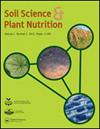有限铁条件下植物有效光合作用的阐释
IF 1.8
4区 农林科学
Q3 ENVIRONMENTAL SCIENCES
引用次数: 7
摘要
植物将光合电子传递系统中的主要元素氮(N)和铁(Fe)大量分配给叶片叶绿体。尽管克服缺氮的分子机制已经被深入研究,但高等植物光合机构对缺铁的适应仍有待进一步研究。我们之前报道了耐缺铁作物大麦叶绿体中的有效策略,这些策略允许在缺铁条件下进行光合作用,而不仅仅依赖于通过根获取铁。缺铁大麦叶片采用至少两种策略,即通过Lhcb1磷酸化诱导吸收光能的热耗散,该磷酸化在缺铁期间无论光照条件如何都能稳定维持;通过成分未知的蛋白质复合物改善光系统I内或周围的电子流。以前的研究主要集中在健康的叶片上,因为叶绿体很容易从叶片中分离出来,或者在模式生物上,如拟南芥和蓝藻上,来展示典型的光系统结构和光化学反应。相比之下,在非模式植物中,非典型光系统结构和组成已被报道。这些结构通常对适应压力条件或特定的生态位很重要。本文综述了大麦光系统对铁缺乏的适应机制,并对其他植物在不同胁迫条件下的光系统调节进行了综述。本文章由计算机程序翻译,如有差异,请以英文原文为准。
Elucidation of efficient photosynthesis in plants with limited iron
ABSTRACT Plants allocate large proportions of nitrogen (N) and iron (Fe) – principal elements in the photosynthetic electron transport system – to leaf chloroplasts. Although the molecular mechanisms to overcome N deficiency have been intensively studied, the acclimation of photosynthetic apparatus to Fe deficiency in higher plants remains to be further investigated. We previously reported about effective strategies in the chloroplasts of an Fe-deficiency-tolerant crop, barley, which allow photosynthesis under Fe-deficient conditions, not relying solely on Fe acquisition via the roots. The Fe-deficient barley leaves employ at least two strategies, viz., induction of thermal dissipation of absorbed light energy via Lhcb1 phosphorylation, which is maintained stably over Fe-deficiency periods regardless of light conditions, and improved electron flow in or around photosystem I through protein complexes with unknown composition. Previous studies have focused on healthy leaves from which chloroplasts can easily be isolated or on model organisms, such as Arabidopsis and cyanobacteria, to demonstrate typical photosystem structures and photochemical reactions. By contrast, in non-model plants, atypical photosystem structures and compositions have been reported. These structures are generally important to adapt to stress conditions or specific niches. In this review, we elucidate the mechanisms of acclimation of barley photosystems to Fe deficiency and provide an overview of the modulations in the photosystems of other plants under various stress conditions.
求助全文
通过发布文献求助,成功后即可免费获取论文全文。
去求助
来源期刊

Soil Science and Plant Nutrition
农林科学-农艺学
CiteScore
4.80
自引率
15.00%
发文量
56
审稿时长
18-36 weeks
期刊介绍:
Soil Science and Plant Nutrition is the official English journal of the Japanese Society of Soil Science and Plant Nutrition (JSSSPN), and publishes original research and reviews in soil physics, chemistry and mineralogy; soil biology; plant nutrition; soil genesis, classification and survey; soil fertility; fertilizers and soil amendments; environment; socio cultural soil science. The Journal publishes full length papers, short papers, and reviews.
 求助内容:
求助内容: 应助结果提醒方式:
应助结果提醒方式:


